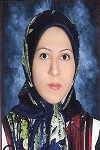
Samira Berenji Ardestani
Professor Assistant, Radiation Application Research School, Iran
Title: Some physicochemical properties of iranian native barberry fruits (abi and poloei): Berberis integerrima and berberis vulgaris
Biography
Biography: Samira Berenji Ardestani
Abstract
Owing to a combination of medicinal and nutritional values (functional food); barberry plants are of interest to researchers. Barberry is a valuable native Iranian plant which is cultivated as abi and poloei varieties (Berberis integerrima - B. vulgaris). Amounts of ash (1.0671- 0.7363%), fat (2.9674 - 0.6173%), fiber (12.1059 - 2.6222%), protein (0.5043 - 0.1200%), reducing sugars (8.8426 - 6.6671%), total sugar (13.8573 - 9.4827%) and pH (3.160 -3.060) were higher in integerrima whereas moisture content (56.27 - 75.01%), Brix (11.1666 - 17.3333) and colour indexes (L*: 16.8500 - 20.8200, a*: 5.6866 - 34.8400 and b*: -1.0066 - 18.9066) were higher in vulgaris. The amounts of P, Zn, Fe, Na and K (ICP technique) in vulgaris were significantly higher than those of integerrima (whole and seedless fruits) and the highest amounts of Mn, Mg, and Cu, Ca were recorded in whole and seedless fruits of integerrima, respectively. Total phenolic and total anthocyanin contents were 8530 and 183.51 mg in 100 g fresh fruits of B. integerrima (as major anthocyanin delphinidin-3-glucoside equivalent), 3450 and 14.8 mg in 100 g fresh fruits of B. vulgaris (as major anthocyanin pelargonidin-3-glucoside equivalent), respectively.

